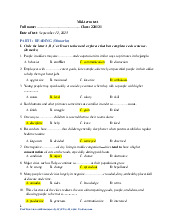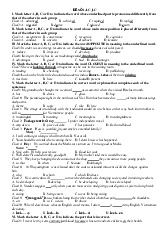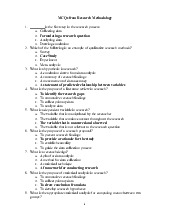










Preview text:
UNIT 17 – TEAM BUILDING – A KEY TO SUCCESS Câu 1:
This term describes a work stoppage initiated by employees to enforce demands or address grievances. A. Lockout B. Strike C. Boycott D. Picketing Câu 2:
This type of bargaining involves multiple employers negotiating with a single labor union. A. Collective Bargaining
B. Multi-Employer Bargaining C. Individual Bargaining D. Sectoral Bargaining Câu 3:
It is a strategy where management prevents employees from working during a labor dispute. A. Strike B. Boycott C. Lockout D. Picketing Câu 4:
This term refers to the legal protection that ensures employees can engage in
collective bargaining without fear of retaliation. A. Labor Union B. Worker Rights
C. Collective Bargaining Agreement D. Right to Organize Câu 5:
It is the union's responsibility to represent all members fairly during the bargaining process. A. Duty of Care
B. Duty of Fair Representation C. Duty of Loyalty D. Duty of Good Faith Câu 6:
The process of distributing and entrusting work to another person. A. Delegation B. Task Force C. Team Structuring D. Groupthink Câu 7:
This type of bargaining focuses on mutual gains and problem-solving rather than conflict. A. Adversarial Bargaining B. Distributive Bargaining
C. Integrative Bargaining D. Positional Bargaining Câu 8
It refers to activities aimed at improving interpersonal relationships and group dynamics within a team. A. Team Building B. Conflict Resolution C. Performance Management D. Organizational Development Câu 9:
This term describes the process of dividing a team into sub-groups to accomplish specific tasks. A. Delegation B. Task Force C. Team Structuring D. Groupthink Câu 10:
It is the initial phase where team members get to know each other and establish ground rules. A. Storming B. Norming C. Performing D. Forming Câu 11:
This stage of team development involves resolving conflicts and establishing a team hierarchy. A. Storming B. Norming C. Performing D. Forming Câu 12:
It refers to the temporary grouping under one leader for the purpose of
accomplishing a definite objective. A. Task force B. Leadership C. Management D. Supervision Câu 13:
This term describes the phenomenon where team members exert less effort
because they feel less accountable. A. Groupthink B. Social Loafing C. Cohesion D. Conformity Câu 14:
Role-playing or roleplaying is the changing of one's behaviour to assume a role,
either unconsciously to fill a social role, or consciously to act out an adopted role. A. Cross-Training B. Job Rotation C. Role Playing D. Delegation Câu 15:
This type of team consists of members from different departments working
together on a specific project. A. Virtual Team B. Functional Team
C. Cross-Functional Team D. Self-Directed Team Câu 16:
It is the act of setting specific, measurable, achievable, relevant, and time-bound objectives for a team. A. Goal Setting B. Performance Management C. Strategic Planning D. Task Allocation Câu 17:
This method of team building focuses on developing trust, communication, and problem-solving skills. A. Icebreaker Activities B. Skill-Building Workshops
C. Trust-Building Exercises D. Performance Reviews Câu 18:
It refers to the ability to influence and guide individuals or groups towards achieving goals. A. Management B. Supervision C. Leadership D. Administration Câu 19:
This leadership style involves making decisions unilaterally and expecting
subordinates to follow orders. A. Democratic Leadership
B. Autocratic Leadership C. Laissez-Faire Leadership
D. Transformational Leadership Câu 20:
It is a leadership approach that focuses on inspiring and motivating followers to
achieve extraordinary outcomes. A. Transactional Leadership
B. Transformational Leadership C. Servant Leadership D. Charismatic Leadership Câu 21:
This type of leadership emphasizes participation and collaboration in decision- making processes. A. Autocratic Leadership B. Transactional Leadership
C. Democratic Leadership
D. Transformational Leadership Câu 22:
It refers to a leadership style where the leader takes a hands-off approach and
allows team members to make decisions. A. Autocratic Leadership
B. Laissez-Faire Leadership
C. Transformational Leadership D. Servant Leadership Câu 23:
Deals with the strategies, tactics and processes for identifying, recruiting and
retaining the human resources a company needs. A. Succession Planning B. Performance Management C. Talent Acquisition D. Workforce Planning Câu 24:
It involves a leader providing guidance and support while allowing employees autonomy in their work. A. Autocratic Leadership
B. Participative Leadership C. Situational Leadership D. Directive Leadership Câu 25:
This leadership theory suggests that the best leadership style depends on the
situation and the followers' needs. A. Trait Theory B. Behavioral Theory
C. Situational Leadership Theory
D. Transformational Leadership Theory Câu 26
It refers to the ability of a leader to understand and manage their own emotions and those of others.
A. Emotional Intelligence B. Cognitive Intelligence C. Social Intelligence D. Cultural Intelligence Câu 27:
It refers to the leadership philosophy in which the goal of the leader is to serve. A. Autocratic Leadership
B. Transformational Leadership C. Servant Leadership D. Transactional Leadership Câu 28:
It involves rewarding employees for meeting or exceeding performance expectations.
A. Transformational Leadership
B. Transactional Leadership C. Laissez-Faire Leadership D. Autocratic Leadership Câu 29:
This term describes a leader's ability to create a compelling vision and inspire others to achieve it. A. Strategic Planning
B. Visionary Leadership C. Operational Leadership D. Tactical Leadership Câu 30:
This is about creating and allocating resources ahead of the action. A. Strategic Planning B. Visionary Leadership C. Operational Leadership D. Tactical Leadership Câu 31:
Type of leadership where a chain of commands is passed down to subordinates by the leader at the top. A. Delegative Leadership B. Participative Leadership C. Autocratic Leadership D. Directive Leadership Câu 32:
This type of leader inspires followers through their charisma and personal appeal. A. Servant Leader B. Transactional Leader C. Charismatic Leader D. Transformational Leader Câu 33:
The activity of managing a department, project, etc. and of making sure that
things are done correctly and according to the rules. A. Management B. Supervision C. Leadership D. Coaching Câu 34:
This term describes a leader who focuses on tasks, rewards, and punishments to achieve results. A. Transformational Leader
B. Transactional Leader C. Servant Leader D. Visionary Leader Câu 35:
This leadership style involves creating and sharing a clear vision to guide the organization.
A. Visionary Leadership B. Transactional Leadership C. Laissez-Faire Leadership D. Servant Leadership Câu 36:
This term describes the shared norms, values, and behaviors within a team. A. Team Structure B. Team Culture C. Team Dynamics D. Team Performance
Câu 37: Effective team building requires strong among team members. A. competition B. collaboration C. isolation D. indifference
Câu 56: Leadership is often characterized by the ability to and inspire others towards a common goal. A. manipulate B. demotivate C. motivate D. segregate
Câu 38: A key aspect of successful team building is fostering a sense of among team members. A. competition B. camaraderie C. conflict D. apathy
Câu 39: Effective leadership involves
a clear vision and direction for the team. A. obscuring B. defining C. neglecting D. ignoring
Câu 40: Team building activities aim to enhance
and cooperation among team members. A. competition B. conflict C. collaboration D. isolation
Câu 41: A good leader is able to
the strengths and weaknesses of team members and delegate tasks accordingly. A. ignore B. recognize C. exacerbate D. diminish
Câu 42: Trust is an essential component of successful team building, as it fosters and open communication. A. suspicion B. distrust C. transparency D. secrecy
Câu 43: Effective leaders often demonstrate
by taking responsibility for both successes and failures. A. accountability B. blame-shifting C. evasion D. negligence Câu 44: In team building,
refers to the ability of team members to work together towards a common goal. A. competition B. collaboration C. conflict D. isolation Câu 45:
is the process of guiding and directing the behavior of others towards the achievement of goals. A. Management B. Leadership C. Dictatorship D. Subjugation
Câu 46: Effective team building often involves
communication channels to facilitate information flow. A. blocking B. limiting C. opening D. obstructing
Câu 47: A key characteristic of successful leaders is their ability to and adapt to changing circumstances. A. resist B. embrace C. avoid D. deny
Câu 48: Team building exercises can help identify and
team strengths and weaknesses. A. ignore B. exacerbate C. exploit D. address Câu 49:
refers to the ability to influence and inspire others to achieve a common goal. A. Domination B. Coercion C. Leadership D. Subjugation
Câu 50: Effective team building often involves
individual differences and fostering inclusivity. A. exacerbating B. celebrating C. ignoring D. dismissing




